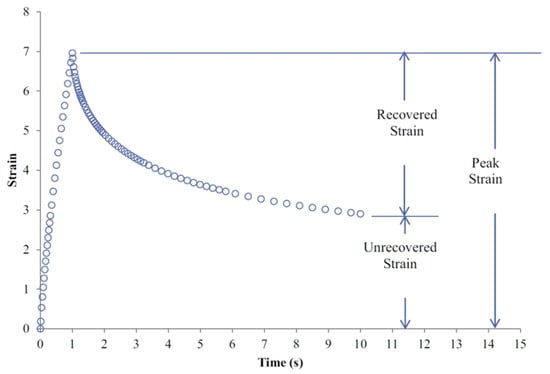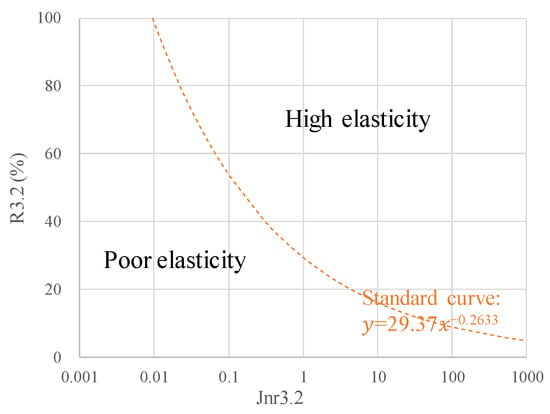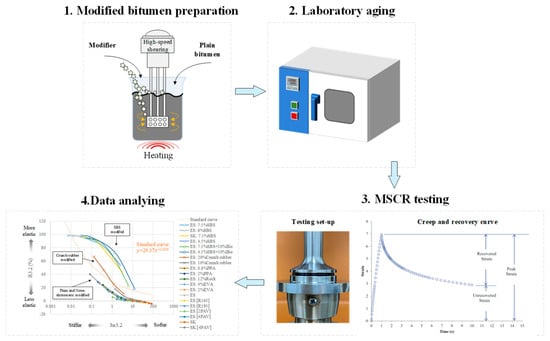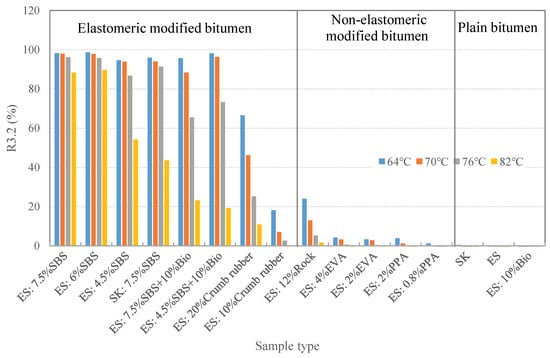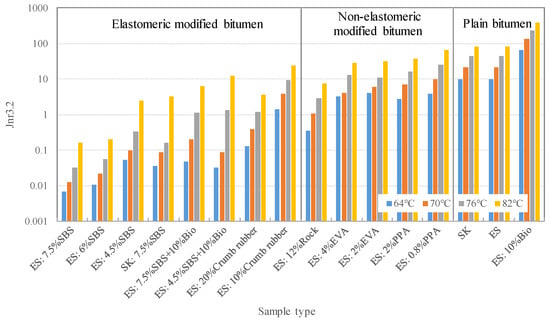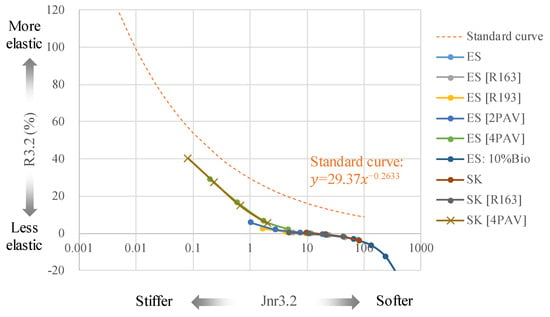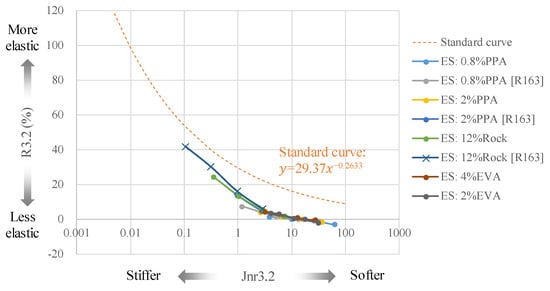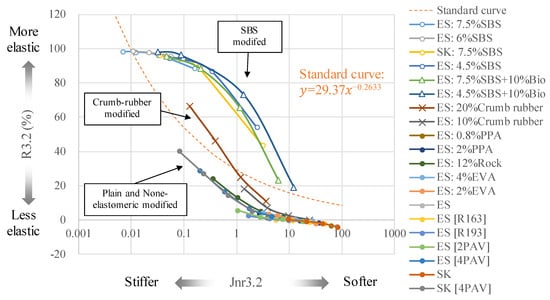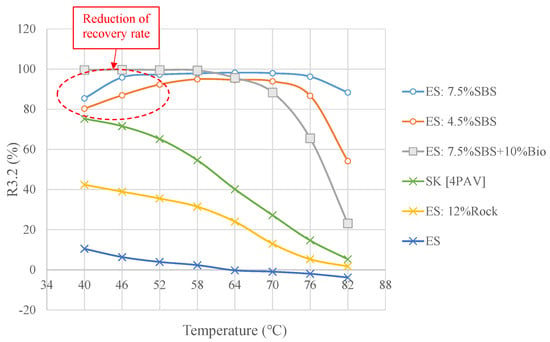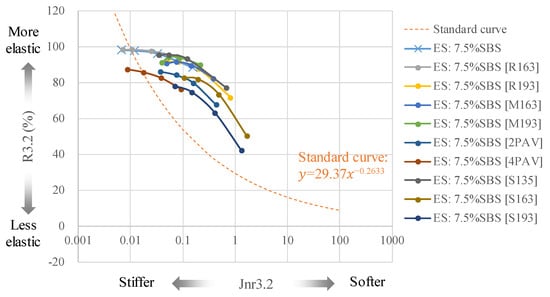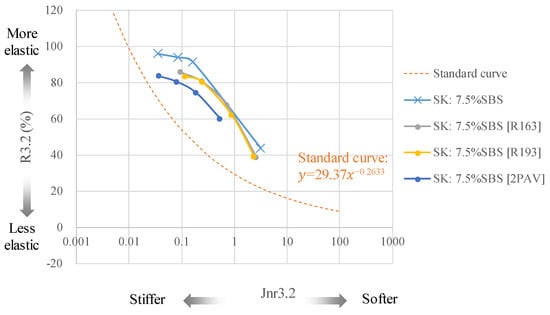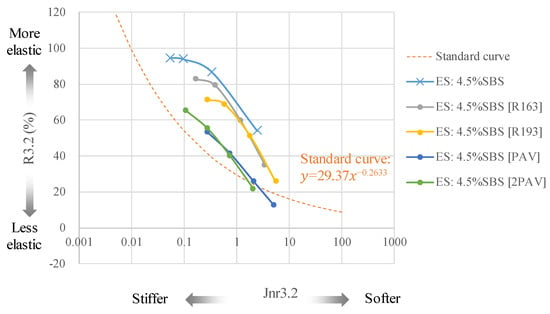Abstract
In recent decades, the application of modified bitumens has experienced tremendous growth. However, due to the varying modification mechanism of different modifiers, the creep and recovery properties of modified bitumen have not been comprehensively understood. This study aims to evaluate the creep and recovery properties of several representative modified bitumens using the multi-stress creep recovery (MSCR) test. The MSCR test can highlight the unique delayed elasticity of modified bitumen and it uses a high stress level, which is more comparable to the field. In particular, this test also aims to identify the effects of different aging conditions. To do so, a total of 15 bitumens, including 7 elastomeric-modified bitumens, 5 non-elastomeric-modified bitumens, and 3 plain bitumens, were prepared and examined. Furthermore, 10 different aging conditions were considered. The results suggest that the generation mechanism of elasticity varies for different modified bitumens. There are two types of elasticities, which are energy elasticity and entropy elasticity, and their differences need more attention in the road bitumen material community. Aging changes the percentages of contributions from energy elasticity and entropy elasticity to the bitumen’s overall recovery performance. The increase in “bad” energy elasticity may compensate for part of the “good” entropy elasticity loss, but overall, the bitumen’s recovery rate is decreasing and the ratio of energy elasticity is increasing, which might hinder the bitumen’s road performance.
1. Introduction
As a result of the increased demand placed on highways from higher traffic volumes and heavier loads, bitumen with better rheological properties is gaining more attention [1]. Bitumens modified with polymers and other additives show improved rheological properties such as higher modulus and higher elasticity, which can significantly enhance the pavement deformation resistance at high temperatures. In recent decades, the application of modified bitumens has experienced tremendous growth. There are numerous modifiers available, and the Styrene-Butadiene-Styrene (SBS) polymer is among one of the most used ones [2]. SBS polymer can form a three-dimensional rubbery network within the bitumen, which significantly benefits pavement performance [3].
Besides using SBS, a more economical approach to modifying the bitumen could be possible via the use of small amounts of modifiers. In this sense, polyphosphoric acid (PPA) might be a good alternative [4]. Some studies have suggested that small amounts of PPA show a comparable effect as other polymers [5]. Yang et al. [6] evaluated the possibility of a composite modifying PPA with SBS and bio-oil and achieved good performances. Besides SBS and PPA, ethyl vinyl acetate (EVA) [7,8] and natural rock bitumen [9] are also commonly used modifiers to improve the bitumen performance. Wentao et al. [10] reviewed the recent progress of EVA bitumen and claimed the utilization of EVA sees notable growth due to its rigid three-dimensional network structure and special functional groups.
The application of recycled and environmentally friendly materials is also trending in the road bitumen material community. Two representative examples are crumb rubber particles and bio-oil. Abundant researchers have reported that crumb rubber can improve the bitumen’s rheological properties by increasing the bitumen viscosity, modulus, and elasticity [11,12]. Bio-oil, as a renewable material, can enhance the bitumen’s fatigue and low-temperature properties [13]. Some also claimed that bio-oil facilitates the swelling of the polymer and thus helps with the compatibility between the polymer and base bitumen [14].
Bitumen is a typical viscoelastic material, and some of them (especially modified ones) exhibit notable elasticities. Many studies have indicated there are obvious positive correlations between the elasticity of bitumen and its mechanical properties [15,16], as good elasticities improve the bitumen’s overall properties such as better rutting resistance and better fatigue resistance. To better evaluate the modified bitumen regarding its elasticity and creep/recovery behaviors, D’angelo [17] proposed a test named multi-stress creep recovery (MSCR). The MSCR test uses the well-established creep and recovery test concept from polymer testing to evaluate the bitumen’s elasticity and potential for permanent deformation [18]. The MSCR test is operated in rotational mode using 1 s creep load followed by 9 s recovery, and then the compliance and recovery rate are recorded for analysis. MSCR has been quickly accepted as one of the most popular experiments for modified bitumens. Yanlei’s [19] study used MSCR as a useful method to optimize the preparation procedures of various modified bitumens.
The MSCR test has two main advantages. First, it utilizes a relatively high stress level (3.2 kPa or even higher), which is comparable with the field. Second, the MSCR test leaves much time for the material to recover. Therefore, the effects of time-dependent entropy elasticity or delayed elasticity from elastomeric modifiers are revealed. These two aspects allow the MSCR to accurately quantify the performance of both plain bitumen and modified bitumen. Moreover, since the strain and stress data during the MSCR can be recorded with a high resolution, researchers can fit the creep and recovery behavior using physical modeling or numerical simulation to achieve in-depth and quantitative analysis [20,21].
Besides the influence of modification, aging is another essential factor that changes the bitumen’s creep and recovery properties. It has been widely accepted that aging can negatively influence the performance of asphalt mixtures. In recent research carried out by Haichuan et al. [22], dynamic modulus and uniaxial fatigue tests were performed to investigate the stiffness and cracking properties of specimens after different aging durations, and the results suggest that aging can notably impair the mixtures’ fatigue resistance. However, currently, there is no clear conclusion on how aging will change the bitumen’s elasticity. Some claimed that thermal aging could stiffen the bitumen and push it to a more elastic end [23]. Li et al. [24] indicated that asphaltenes had a skeleton function so the modified bitumen with a high content of asphaltene presented a strong elastic response after long-term aging. However, on the other hand, numerous studies have reported that polymer-modified bitumen could be vulnerable to thermal aging and polymer oxidative degradation will weaken the modified bitumen’s elasticity [25,26]. To overcome the negative consequences of aging, Lijun et al. [27] even explored the possibility of lignin, quercetin, and gallic acid as antioxidants in asphalt.
This study aims to evaluate the creep and recovery properties of several representative modified bitumens using the MSCR test. It can highlight the unique delayed elasticity of modified bitumen and it uses a high stress level, which is more comparable to the field. In particular, this test aims to investigate the effects of aging and different testing temperatures. To achieve this aim, a total of 15 bitumens, including 7 elastomeric-modified bitumens, 5 non-elastomeric-modified bitumens, and 3 plain bitumens, were prepared and examined. Furthermore, 10 different aging conditions were considered. After the MSCR test, the recovery rate and non-recoverable compliance were recorded for analysis.
2. Experimental Design
2.1. Materials
2.1.1. Raw Materials
In this study, a total of 15 bitumens, including 7 elastomeric-modified bitumens, 5 non-elastomeric-modified bitumens, and 3 plain bitumens, were investigated and compared. Modified bitumens were prepared with either ES base bitumen, SK base bitumen, or ES base bitumen coupled with 10% bio-oil. The basic information on raw materials for bitumen preparation is summarized in Table 1. The raw materials were selected based on common selections in the industry.
2.1.2. Bitumen Modification and Preparation
In this study, 13 modified bitumens were prepared and examined. They were all laboratory prepared by mixing the plain bitumen with selected modifiers. The specific mixing processes varied based on the type of modifier used. For EVA, PPA, and rock bitumen-modified bitumens, plain bitumen was first heated to 160 °C to achieve fluidity and then the desired modifiers were added to the hot bitumen. Subsequently, the blend was sheared for 20 min (4000 rpm) and then stirred for 60 min (800 rpm). For the SBS-modified bitumen (SBSMB) and crumb rubber-modified bitumen, mixing was carried out at 180 °C, and the shearing stage was extended to 120 min to achieve better swelling and homogeneity. The stability of modified bitumens used in this study has been verified using the cigar-tube separation test.
2.1.3. Laboratory Aging
According to AASHTO T350, a standard MSCR test requires RTFO aging before testing to simulate the short-term aging during asphalt mixture mixing and paving. To discuss the influence of aging, this study used 10 different laboratory aging processes including RTFO aging. The applied aging processes are summarized in Table 2.
2.1.4. Summary of Tested Bitumen Samples
A summary of the experimental matrix is presented in Table 3. The content of the modifiers was selected based on the common ranges of their applications in the industry.
In this study, samples at different aging levels are coded as “Bitumen ID [Aging level]”. For instance, “SK: 7.5%SBS” and “SK: 7.5%SBS [2PAV]” refer to unaged SK-based 7.5% SBS-modified bitumen and double PAV-aged SK-based 7.5% SBS-modified bitumen, respectively (“VG”, which represents the unaged status, is omitted).
2.2. MSCR Testing Procedure
The TA DHR-3 type DSR was used to perform the MSCR test. The 25 mm parallel plate with a 1 mm gap was selected. The bitumen was first heated to 165 °C to remove any thermal history, and then the liquid bitumen sample was dripped into a silicon mold to prepare the sample for MSCR testing.
According to AASHTO T350, the MSCR test was operated in rotational mode using a 1 s creep load followed by a 9 s recovery for each cycle. Twenty creep and recovery cycles were run at 0.1 kPa creep stress followed by ten cycles at 3.2 kPa creep stress. Figure 1 presents a typical creep and recovery cycle. For each cycle, two parameters, the percent recovery (R) and non-recoverable creep compliance (Jnr), are calculated following Equations (1) and (2):
where represents the peak strain, represents the unrecovered strain, and is the stress level (either 0.1 kPa or 3.2 kPa).
Then, the average percent recovery at 0.1 kPa and 3.2 kPa is calculated and expressed as R0.1 and R3.2, respectively. The average non-recoverable creep compliance at 0.1 kPa and 3.2 kPa is expressed as Jnr0.1 and Jnr3.2. This study only investigates the measurements of 3.2 kPa (R3.2 and Jnr3.2) because a higher stress level is considered to be more comparable with the field. Some European agencies are even running MSCR at 10 kPa. The test was conducted at 4 different temperatures (64 °C, 70 °C, 76 °C, and 82 °C), hence the influence of temperature could be discussed.
2.3. MSCR Curve
The AASHTO T350 specification also includes a technique to further evaluate the bitumen creep and recovery behavior. This technique is referred to as the MSCR curve or polymer curve [29]. An MSCR curve is established by plotting R3.2 against Jnr3.2 (shown in Figure 2). A standard curve depicted as Equation (3) is used to examine whether the bitumen has enough elastic response for elastomeric-modified bitumen.
where y is R3.2 and x is Jnr3.2.
Figure 2.
Diagram of the MSCR curve and standard curve to determine the minimum R3.2 for measured Jnr3.2.
According to D’angelo’s work [17], this standard curve is an empirical decision based on numerous modified bitumen samples. This curve will assure that the polymer-modified bitumens have well-developed polymer networks. The MSCR curve is not commonly employed in the literature, but authors find it could be a useful tool to analyze the bitumen creep and recovery properties. In this study, the MSCR curve is applied for more in-depth analysis.
A flowchart is shown in Figure 3 to help understand the methodology of this study.
3. Results and Discussion
3.1. Comparison between Different Modifiers
In this section, all seven elastomeric-modified bitumens, five non-elastomeric-modified bitumens, and three plain bitumens are compared in terms of their R3.2 and Jnr3.2. Only unaged virgin bitumens are discussed in this section. The influence of aging will be discussed later. The testing results of R3.2 and Jnr3.2 are summarized in Figure 4 and Figure 5, respectively.
Figure 4 shows that elastomeric-modified bitumens have the highest recovery rate, followed by non-elastomeric-modified bitumens and plain bitumens. Specific to each modifier, SBS shows the highest recovery rate, followed by crumb rubber and rock bitumen. EVA and PPA do not show any evident improvement in the recovery rate. Bio-oil notably diminishes bitumen’s recovery rate as bio-oil-modified SBSMBs are less elastic than conventional SBSMB with the same SBS content.
The summary of Jnr3.2 is shown in Figure 5. It shows that elastomeric-modified bitumens have the best permanent deformation resistance (lowest Jnr3.2), followed by the non-elastomeric-modified bitumens and plain bitumens. Specific to each modifier, SBS shows the smallest Jnr3.2, followed by crumb rubber and rock bitumen. EVA and PPA modification slightly decrease the Jnr3.2 for plain bitumen. Bio-oil notably diminishes bitumen’s deformation resistance as bio-modified bitumens show much more increased Jnr3.2 than conventional plain bitumen-based bitumens. These observations are consistent with previous studies that show that SBS polymer-modified asphalt has good rutting resistance [30] and bio-oil may hinder the bitumen rutting resistance [31].
It is worth mentioning that SK: 7.5%SBS only shows comparable Jnr3.2 and R3.2 with ES: 4.5%SBS. This observation highlights the significant influence of the base bitumen source on the rheological properties of SBS-modified bitumen. The SBS polymer swells better in an aromatic fraction. Since ES bitumen contains a higher proportion of the aromatic fraction, it is often considered an ideal base bitumen for modification.
3.2. MSCR Testing Results for Plain Bitumens
A separate discussion on R3.2 or Jnr3.2 is not sufficient to fully explain the creep and recovery behavior of bitumens. In this section, the MSCR curve is applied for more in-depth analysis. Moreover, laboratory-aged bitumens are examined.
An MSCR curve for plain bitumen is established in Figure 6. Three plain bitumens, which are ES, SK, and ES: 10%Bio, and their aged replicates are evaluated. For each bitumen at each aging level, results from four different temperatures (64 °C, 70 °C, 76 °C, and 82 °C) are plotted together as a series, highlighting the temperature-induced trends. Noted for the purpose of conciseness, the testing temperature is not labeled in the graph. To tell which data point corresponds to which temperature, the data points of 64 °C are always at the left-top end of the series line because 64 °C yields the highest stiffness and highest recovery rate, followed by data points of 70 °C, 76 °C, and 82 °C.
From Figure 6, it is very interesting to see that all points converge onto a smooth “master curve”, irrespective of the bitumen type or aging level. This master curve is lower than the standard curve, indicating these plain bitumens are not elastic enough to be categorized as elastomer-modified asphalt. Aging and reduced testing temperatures will bring the recovery rates to a higher level but will not make the curve cross the standard curve.
This smooth master curve suggests that there is a strong correlation between the plain bitumen’s recovery rate and its stiffness. Due to its relatively low molecular weight and absence of a long-chain polymer network, plain bitumen relies predominantly on molecular internal energy changes for its elasticity [32]. This type of elasticity, referred to as energy elasticity, exhibits a significant dependence on bitumen stiffness. In other words, variables such as the testing temperature and aging level affect the bitumen recovery rate by changing its stiffness.
3.3. MSCR Testing Results for Non-Elastomeric-Modified Bitumens
Three non-elastomeric modifiers, which are rock bitumen, PPA, and EVA, are evaluated in this section. The MSCR curve for non-elastomeric-modified bitumens is drawn in Figure 7 following the same pattern as Figure 6. Results show that these non-elastomeric-modified bitumens behave very much like plain bitumen. Similarly, a smooth and continuous master curve is observed, and it almost overlaps with the one generated from plain bitumens. Their master curves both start from (0.1, 40) and cross the Jnr3.2 axis around 10. This similarity can be comprehended as a non-elastomeric modifier also acquiring its elasticity mainly from internal energy changes. According to Cheng’s work [33], adding rock bitumen will increase the asphaltene/heavy molecule ratio and result in an increase in stiffness. The mechanism is quite similar to aging because aging will also bring more heavy molecules into the system. With the increase in heavy molecular and chemical fractions, the inter-molecular interaction becomes stronger, and thus the bitumen becomes stiffer and shows an increased elastic response.
3.4. MSCR Testing Results for Elastomeric-Modified Bitumens
Two commonly used elastomeric modifiers, namely SBS and crumb rubber, are tested in this study. Note that only unaged modified bitumens are discussed in this section because it is found that in terms of aging, elastomeric-modified bitumens’ responses are much more complicated and thus will be discussed in a separate section.
Following the same fashion, a master curve is established for elastomeric-modified bitumens. The results are shown in Figure 8. For comparison, plain bitumens and non-elastomeric-modified bitumens are also included in Figure 8.
According to Figure 8, SBSMB shows the most improved elastic response. Crumb rubber-modified bitumen also shows higher elasticity than plain bitumen, but the improvement is not comparable with SBSMB. Moreover, 20% crumb rubber-modified bitumen meets the standard curve at 64 °C and 70 °C. However, further increases in temperature will make it unqualified. In addition, 10% crumb rubber-modified bitumen fails the standard curve at all testing temperatures. The relatively lower recovery rate of crumb rubber-modified bitumen is possibly explained by the poor compatibility between crumb rubber and plain bitumen [34].
It can be seen that SBSMB shows more elasticity (R3.2) than plain/non-elastomeric bitumen at any specific stiffness (Jnr3.2). This highlights the different origins of elasticity between these bitumens. For plain bitumen and non-elastomeric-modified bitumen, the elasticity is mainly attributed to internal energy change, whereas SBSMB acquires its elasticity from both the internal energy change (energy elasticity) and the rubbery polymer network (entropy elasticity).
According to thermodynamics, the elastic behavior of materials is governed by Helmholtz’s free energy [35], which is expressed as Equation (4) and has two parts: The energy term and the entropy term.
where F is free energy, U is (internal) energy, T is temperature, and S is entropy.
F = U − TS
When deformed, molecules “want” to go back to the state with minimal free energy, that is, to minimize their internal energy and maximize their entropy. Therefore, depending on whether the energy or the entropy term dominates the free energy, the elasticity can be classified as energy-elasticity and entropy-elasticity. While low-molecular-weight materials such as plain bitumen usually show energy elasticity, high-molecular-weight materials such as elastomer and elastomer-modified bitumen can exhibit a considerable portion of entropy elasticity.
Due to the fundamental difference in the generating mechanism, entropy elasticity has a much higher yield strain and is less temperature-sensitive than energy elasticity. In fact, entropy elasticity is positively proportional to the temperature increase because a higher ambient temperature facilitates molecular thermal motions [36]. Both energy elasticity and entropy elasticity lead to improved recovery rates but energy elasticity does not always translate to better field performance. Stiff bitumen that shows considerable energy elasticity could also be vulnerable to fatigue and cracking damage.
In terms of applications in bitumen concrete pavement, entropy elasticity might be considered a “better” kind of elasticity. It improves the bitumen’s overall properties such as better rutting resistance (higher recovery rate), better fatigue resistance (higher yield strain), and better low-temperature cracking resistance (less temperature-sensitive). Many studies have indicated there are obvious correlations between the elasticity of bitumen and its mechanical properties [15,16]. However, no wide-accepted performance standard has been established based on bitumen’s elasticity properties. This might be because insufficient attention has been paid to differentiating the origin of elasticity (energy or entropy). This research field requires more in-depth studies.
3.5. Temperature Sensitivity of Recovery Rate
The difference between energy elasticity and entropy elasticity in terms of temperature sensitivity is examined in this section. The influence of temperature on the bitumen recovery rate (R3.2) is shown in Figure 9. To highlight the difference, only six representative bitumens are listed in this section, and the testing temperature range is broadened to 40 °C~82 °C with a 6 °C gap.
Based on the available data, stiff samples such as non-elastomeric-modified bitumen (ES:12%Rock) and seriously aged bitumen (SK [4PAV]) show the most obvious temperature sensitivity, highlighting the strong temperature sensitivity of energy elasticity. This sensitivity is explained by the fact that stiff material has higher intermolecular forces, which translate to higher internal force and consequently higher temperature sensitivity. SBSMB on the other hand does not show much temperature sensitivity because it does not rely on stiffness to gain its elasticity. Instead, entropy elasticity is the main source, and it is much less temperature-sensitive. SBSMB does not show a noticeable decrease in the recovery rate until 76 °C. Bio-oil-modified SBSMB (marked with squares) show a higher temperature sensitivity than conventional ones, and this is attributed to the viscous nature of bio-oil. This is favorable with related studies showing that bio-oil can hinder the elasticity of bitumens [37].
From Figure 9, it is also interesting to notice that SBSMB exhibits an R3.2 reduction at lower temperatures (marked in red circle). This might be explained by two reasons. First, entropy elasticity is fundamentally attributed to the thermal motion of polymer chains, and thus a lower ambient temperature will weaken the molecular thermal motion, as well as the entropy elasticity. Second, bitumen stiffens at lower temperatures, and it hinders the relaxation of polymer chains. Either way, this is a noteworthy phenomenon because the MSCR test is always conducted at relatively high temperatures (usually PG temperatures) while the pavement spends most of its service life at intermediate temperatures. Recovery rate measurements at intermediate temperatures may require more attention.
3.6. Effects of Aging on SBS-Modified Bitumens
The influence of aging on SBSMB is discussed in this section. Depending on the difference in base bitumen source and SBS content, three representative SBSMB are investigated in this section, which are ES: 7.5%SBS, SK: 7.5%SBS, and ES: 4.5%SBS. The results for aged ES: 7.5%SBS bitumens are presented in Figure 10.
Based on Figure 10, the aging behavior of SBSMB notably differs from plain bitumen or non-elastomeric-modified bitumens in two aspects. First, after aging, SBSMB’s recovery rates tend to decrease rather than increase. Second, the data points of aged SBSMB no longer form a smooth master curve. This phenomenon suggests that the aging process changed the percentages of contributions from energy elasticity and entropy elasticity to the SBSMB’s overall creep and recovery performance. During aging, SBSMB experienced oxidative stiffening coupled with polymer degradation [38], which led to an increase in energy elasticity and a decrease in entropy elasticity. The increase in “bad” energy elasticity may compensate for part of the “good” entropy elasticity loss, but overall, the bitumen’s recovery rate is decreasing and the ratio of energy elasticity is climbing. This variation is not preferable from the perspective of field performance, especially for anti-cracking and anti-fatigue performance.
The results for aged SK: 7.5%SBS bitumens are presented in Figure 11. A similar outcome is seen for SK: 7.5%SBS as a smooth master curve is no longer observed and the recovery rate tends to decrease after aging.
The results for aged ES: 4.5%SBS bitumens are presented in Figure 12. Similarly, no smooth master curve is seen. Due to the relatively lower SBS dosage and the consequently lower degree of entropy elasticity, it can be seen that part of the data points for the PAV and 2PAV aged ES: 4.5%SBS samples have failed the standard curve. The PAV and 2PAV aged bitumens behave very much like seriously aged plain bitumens. This is a coupled result of oxidative stiffing and polymer degradation. The SBS polymer has a readily oxidizable nature, thus SBSMA is vulnerable to aging. Due care should be taken to prevent excessive aging of SBSMA in case it becomes stiff and brittle like aged plain bitumen.
4. Conclusions
This study aims to evaluate the creep and recovery properties of 15 kinds of representative modified bitumens used in the field based on the MSCR test. The MSCR test can highlight the unique delayed elasticity of modified bitumen and it uses a high stress level, which is more comparable to the field. The bitumens’ temperature sensitivity was examined, and their aging behavior was evaluated based on the consideration of 10 different laboratory aging conditions. The detailed conclusions were as follows:
- For plain bitumen and non-elastomeric-modified bitumen, the elasticity is mainly attributed to the internal energy change (energy elasticity), whereas elastomeric-modified bitumens acquire their elasticity from both energy elasticity and entropy elasticity.
- The difference between energy elasticity and entropy elasticity needs more attention in the road bitumen material community. Compared with energy elasticity, entropy elasticity is less temperature-sensitive and has a higher yield strain. It is considered a “better” kind of elasticity from the field performance perspective.
- High strain creep and recovery tests such as MSCR could be a promising technique to analyze bitumen’s elasticity properties. An interesting “master curve” is observed for different bitumens and can be utilized to discriminate energy elasticity from entropy elasticity.
- The aging process changes the percentages of contributions from energy elasticity and entropy elasticity to the bitumen’s overall recovery performance. The increase in “bad” energy elasticity may compensate for part of the “good” entropy elasticity loss, but overall, the bitumen’s recovery rate is decreasing and the ratio of undesirable energy elasticity is climbing, which might hinder the bitumen’s performance.
Author Contributions
Methodology, G.Z. and J.Z.; Formal analysis, H.H.; Investigation, G.Z., J.Z., H.H. and X.X.; Resources, H.H.; Data curation, X.X.; Writing—original draft, C.Y.; Writing—review & editing, C.Y.; Visualization, G.Z.; Supervision, H.H.; Project administration, C.Y.; Funding acquisition, C.Y. All authors have read and agreed to the published version of the manuscript.
Funding
This research was funded by the National key R&D program of China (2022YFB2602603), Hong Kong scholars program (XJ2022040), National Natural Science Foundation of China (52008353), and Sichuan Youth Science and Technology Innovation Research Team (2021JDTD0023, 2022JDTD0015).
Institutional Review Board Statement
Not applicable.
Informed Consent Statement
Not applicable.
Data Availability Statement
Not applicable.
Conflicts of Interest
The authors declare no conflict of interest.
References
- Lv, Q.; Huang, W.; Sadek, H.; Xiao, F.; Yan, C. Investigation of the rutting performance of various modified asphalt mixtures using the Hamburg Wheel-Tracking Device test and Multiple Stress Creep Recovery test. Constr. Build. Mater. 2019, 206, 62–70. [Google Scholar] [CrossRef]
- Shan, L.; He, H.; Wagner, N.J.; Li, Z. Nonlinear rheological behavior of bitumen under LAOS stress. J. Rheol. 2018, 62, 975–989. [Google Scholar] [CrossRef]
- Yan, C.; Huang, W.; Lin, P.; Zhang, Y.; Lv, Q. Chemical and rheological evaluation of aging properties of high content SBS polymer modified asphalt. Fuel 2019, 252, 417–426. [Google Scholar] [CrossRef]
- Behnood, A.; Olek, J. Rheological properties of asphalt binders modified with styrene-butadiene-styrene (SBS), ground tire rubber (GTR), or polyphosphoric acid (PPA). Constr. Build. Mater. 2017, 151, 464–478. [Google Scholar] [CrossRef]
- Nuñez, J.Y.M.; Domingos, M.D.I.; Faxina, A.L. Susceptibility of low-density polyethylene and polyphosphoric acid-modified asphalt binders to rutting and fatigue cracking. Constr. Build. Mater. 2014, 73, 509–514. [Google Scholar] [CrossRef]
- Yang, X.; Liu, G.; Rong, H.; Meng, Y.; Peng, C.; Pan, M.; Ning, Z.; Wang, G. Investigation on mechanism and rheological properties of Bio-asphalt/PPA/SBS modified asphalt. Constr. Build. Mater. 2022, 347, 128599. [Google Scholar] [CrossRef]
- Hussein, I.A.; Iqbal, M.H.; Al-Abdul-Wahhab, H.I. Influence of M w of LDPE and vinyl acetate content of EVA on the rheology of polymer modified asphalt. Rheol. Acta 2005, 45, 92–104. [Google Scholar] [CrossRef]
- Sengoz, B.; Isikyakar, G. Evaluation of the properties and microstructure of SBS and EVA polymer modified bitumen. Constr. Build. Mater. 2008, 22, 1897–1905. [Google Scholar] [CrossRef]
- Cai, L.; Shi, X.; Xue, J. Laboratory evaluation of composed modified asphalt binder and mixture containing nano-silica/rock asphalt/SBS. Constr. Build. Mater. 2018, 172, 204–211. [Google Scholar] [CrossRef]
- He, W.; Zhao, Z.; Yuan, J.; Xiao, F. Recent development of ethylene–vinyl acetate modified asphalt. Constr. Build. Mater. 2023, 363, 129800. [Google Scholar] [CrossRef]
- Lee, S.; Akisetty, C.K.; Amirkhanian, S.N. The effect of crumb rubber modifier (CRM) on the performance properties of rubberized binders in HMA pavements. Constr. Build. Mater. 2008, 22, 1368–1376. [Google Scholar] [CrossRef]
- Presti, D.L. Recycled tyre rubber modified bitumens for road asphalt mixtures: A literature review. Constr. Build. Mater. 2013, 49, 863–881. [Google Scholar] [CrossRef]
- Lei, Z.; Golalipour, A.; Tabatabaee, H.A.; Bahia, H.U. Prediction of effect of bio-based and refined waste oil modifiers on rheological properties of asphalt binders. In Proceedings of the Transportation Research Board 93rd Annual Meeting, Washington, DC, USA, 12–16 January 2014. [Google Scholar]
- Sun, D.; Sun, G.; Du, Y.; Zhu, X.; Lu, T.; Pang, Q.; Shi, S.; Dai, Z. Evaluation of optimized bio-asphalt containing high content waste cooking oil residues. Fuel 2017, 202, 529–540. [Google Scholar] [CrossRef]
- Johnson, C.; Bahia, H.; Wen, H. Practical application of viscoelastic continuum damage theory to asphalt binder fatigue characterization. Asph. Paving Technol.-Proc. 2009, 28, 597. [Google Scholar]
- Clopotel, C.; Mahmoud, E.; Bahia, H. Modification of the Elastic Recovery Test and its Relationship to Performance Related Properties of Modified Asphalt Binders. In Proceedings of the 90th Annual Meeting of the Transportation Research Board, Washington, DC, USA, 23–27 January 2011. [Google Scholar]
- D’Angelo, J. Development of a Performance Based Binder Specification for Rutting Using Creep and Recovery Testing. Ph.D. Thesis, University of Calgary, Calgary, AB, Canada, 2009. [Google Scholar]
- D’Angelo, J.A. The relationship of the MSCR test to rutting. Road Mater. Pavement Des. 2009, 10 (Suppl. S1), 61–80. [Google Scholar] [CrossRef]
- Wang, Y.; Yi, H.; Liang, P.; Chai, C.; Yan, C.; Zhou, S. Investigation on Preparation Method of SBS-Modified Asphalt Based on MSCR, LAS, and Fluorescence Microscopy. Appl. Sci. 2022, 12, 7304. [Google Scholar] [CrossRef]
- Katiyar, V.; Gupta, A.; Tounsi, A. Microstructural/geometric imperfection sensitivity on the vibration response of geometrically discontinuous bi-directional functionally graded plates (2D FGPs) with partial supports by using FEM. Steel Compos. Struct. Int. J. 2022, 45, 621–640. [Google Scholar]
- Mesbah, A.; Belabed, Z.; Amara, K.; Tounsi, A.; Bousahla, A.A.; Bourada, F. Formulation and evaluation a finite element model for free vibration and buckling behaviours of functionally graded porous (FGP) beams. Struct. Eng. Mech. 2023, 86, 291. [Google Scholar]
- Jia, H.; Chen, H.; Sheng, Y.; Meng, J.; Cui, S.; Kim, Y.R.; Huang, S.; Qin, H. Effect of laboratory aging on the stiffness and fatigue cracking of asphalt mixture containing bamboo fiber. J. Clean. Prod. 2022, 333, 130120. [Google Scholar] [CrossRef]
- Lu, X.; Isacsson, U. Chemical and rheological evaluation of ageing properties of SBS polymer modified bitumens. Fuel 1998, 77, 961–972. [Google Scholar] [CrossRef]
- Li, Z.; Zeng, J.; Li, Y.; Zhao, Z.; Cong, P.; Wu, Y. Effect of bitumen composition on micro-structure and rheological properties of styrene–butadiene–styrene modified asphalt before and after aging. Mater. Struct. 2022, 55, 165. [Google Scholar] [CrossRef]
- Cuciniello, G.; Leandri, P.; Filippi, S.; Presti, D.L.; Losa, M.; Airey, G. Effect of ageing on the morphology and creep and recovery of polymer-modified bitumens. Mater. Struct. 2018, 51, 136. [Google Scholar] [CrossRef]
- Yan, C.; Huang, W.; Zheng, M.; Zhang, Y.; Lin, P. Influence of ageing on high content polymer modified asphalt mixture stripping, cracking and rutting performances. Road Mater. Pavement Des. 2020, 22, 1824–1841. [Google Scholar] [CrossRef]
- Sun, L.; Gu, X.; Hu, D.; Zhou, Z.; Wang, G. Anti-aging mechanism and rheological properties of lignin, quercetin, and gallic acid as antioxidants in asphalt. Constr. Build. Mater. 2023, 369, 130560. [Google Scholar] [CrossRef]
- Bahia, U.H.; Hanson, I.D.; Zeng, M.; Zhai, H.; Khatri, A.M.; Anderson, M.R. Characterization of Modified Asphalt Binders in Superpave Mix Design; Transportation Research Board: Washington, DC, USA, 2001. [Google Scholar]
- Hossain, Z.; Ghosh, D.; Zaman, M.; Hobson, K. Use of the multiple stress creep recovery (MSCR) test method to characterize polymer-modified asphalt binders. J. Test. Eval. 2016, 44, 507–520. [Google Scholar] [CrossRef]
- Huang, W.; Tang, N. Characterizing SBS modified asphalt with sulfur using multiple stress creep recovery test. Constr. Build. Mater. 2015, 93, 514–521. [Google Scholar] [CrossRef]
- Yang, X.; You, Z.; Dai, Q.; Mills-Beale, J. Mechanical performance of asphalt mixtures modified by bio-oils derived from waste wood resources. Constr. Build. Mater. 2014, 51, 424–431. [Google Scholar] [CrossRef]
- Sperling, L.H. Introduction to Physical Polymer Science; John Wiley & Sons: Hoboken, NJ, USA, 2005. [Google Scholar]
- Cheng, L.; Yu, J.; Zhao, Q.; Wu, J.; Zhang, L. Chemical, rheological and aging characteristic properties of Xinjiang rock asphalt-modified bitumen. Constr. Build. Mater. 2020, 240, 117908. [Google Scholar] [CrossRef]
- Wang, H.; Apostolidis, P.; Zhu, J.; Liu, X.; Skarpas, A.; Erkens, S. The role of thermodynamics and kinetics in rubber–bitumen systems: A theoretical overview. Int. J. Pavement Eng. 2020, 22, 1785–1800. [Google Scholar] [CrossRef]
- Roylance, D. Atomistic basis of elasticity. ACE 2000, 5, 3. [Google Scholar]
- Ionescu, T.C.; Edwards, B.J.; Keffer, D.J.; Mavrantzas, V.G. Energetic and entropic elasticity of nonisothermal flowing polymers: Experiment, theory, and simulation. J. Rheol. 2008, 52, 105–140. [Google Scholar] [CrossRef]
- Wang, H.; Ma, Z.; Chen, X.; Hasan, M.R.M. Preparation process of bio-oil and bio-asphalt, their performance, and the application of bio-asphalt: A comprehensive review. J. Traffic Transp. Eng. (Engl. Ed.) 2020, 7, 137–151. [Google Scholar] [CrossRef]
- Yan, C.; Huang, W.; Ma, J.; Xu, J.; Lv, Q.; Lin, P. Characterizing the SBS polymer degradation within high content polymer modified asphalt using ATR-FTIR. Constr. Build. Mater. 2020, 233, 117708. [Google Scholar] [CrossRef]
Disclaimer/Publisher’s Note: The statements, opinions and data contained in all publications are solely those of the individual author(s) and contributor(s) and not of MDPI and/or the editor(s). MDPI and/or the editor(s) disclaim responsibility for any injury to people or property resulting from any ideas, methods, instructions or products referred to in the content. |
© 2023 by the authors. Licensee MDPI, Basel, Switzerland. This article is an open access article distributed under the terms and conditions of the Creative Commons Attribution (CC BY) license (https://creativecommons.org/licenses/by/4.0/).

